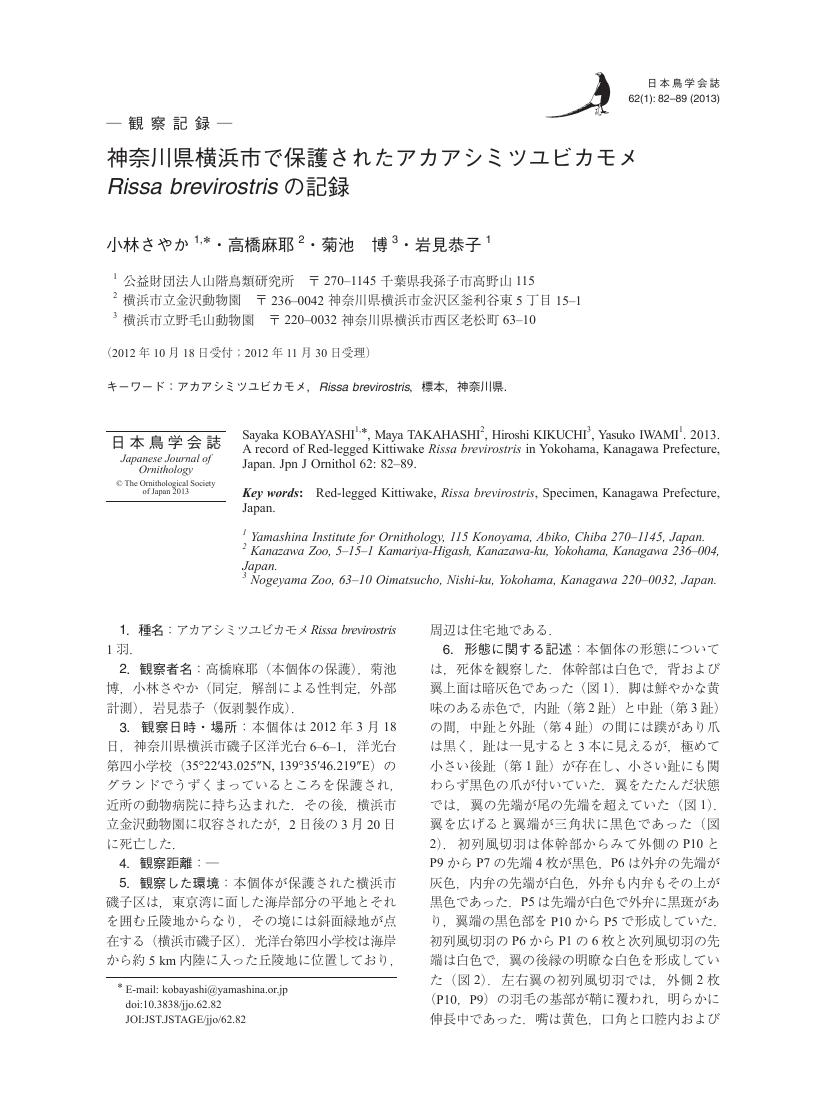- 著者
- 岩見 恭子 小林 さやか 柴田 康行 山崎 剛史 尾崎 清明
- 出版者
- 日本鳥学会
- 雑誌
- 日本鳥学会誌 (ISSN:0913400X)
- 巻号頁・発行日
- vol.64, no.1, pp.63-69, 2015 (Released:2015-04-28)
- 参考文献数
- 19
福島第一原子力発電所の事故によって放出された放射性物質による鳥類の巣の汚染状況を把握するため,2011年に繁殖したツバメの巣を日本全国から採集し,巣材に含まれる放射性セシウム(Cs-134およびCs137)を測定した.全国21都道府県から集められた197巣のうち182巣について測定した結果,1都12県の巣から福島第一原子力発電所由来の放射性セシウムが検出された.福島県内のすべての巣から放射性セシウムが検出され,Cs-134とCs-137の合計の濃度が最も高いものでは90,000 Bq/kgで低いものでは33 Bq/kgであった.巣の放射性セシウム濃度は土壌中の放射性セシウム濃度が高い地域ほど高かったが,地域内で巣のセシウム濃度にはばらつきがみられた.
- 著者
- 小森 日菜子 小林 さやか 川田 伸一郎
- 出版者
- 独立行政法人 国立科学博物館
- 雑誌
- 国立科学博物館研究報告A類(動物学) (ISSN:18819052)
- 巻号頁・発行日
- vol.50, no.1, pp.33-48, 2024-02-22 (Released:2024-02-22)
- 参考文献数
- 65
A mounted skin of unknown species belonging to genus Canis deposited in the National Museum of Nature and Science, Tokyo (NSMT) is certificated morphologically and bibliographically. The specimen label is described as ‘a kind of Yamainu’ and M831 of the Tokyo Imperial Household Museum collection, while the specimen catalog says that M831 was derived from an individual kept at Ueno Zoo and that it was disposed of after. This specimen seemed to be confused with another one. So, we examined the morphological characteristics of this specimen and traced the history of Canis sp. specimens of the Tokyo Imperial Household Museum collection and Canis sp. kept at Ueno Zoo. As a result, measurements of this mounted skin were reasonable to be within the range of specimens previously identified as Japanese wolves. We confirmed that this specimen is correctly labeled as M831. This specimen M831 was considered to be one of two wolves that arrived at Ueno Zoo from Iwate Prefecture, Japan, in 1888. Therefore, it is thought that this specimen is a Japanese wolf. This study may have revealed a new Japanese wolf skin specimen that had previously been overlooked.
2 0 0 0 OA アメリカウミスズメPtychoramphus aleuticusの日本初の標本記録
1 0 0 0 OA 新潟県におけるハジロビタキ Ficedula dumetoria の記録
- 著者
- 小林 さやか 梶田 学 百瀬 邦和 米田 重玄 風間 辰夫
- 出版者
- 公益財団法人 山階鳥類研究所
- 雑誌
- 山階鳥類学雑誌 (ISSN:13485032)
- 巻号頁・発行日
- vol.41, no.2, pp.214-219, 2010-03-25 (Released:2012-03-25)
- 参考文献数
- 11
- 被引用文献数
- 1 1
A specimen of Rufous-chested Flycatcher Ficedula dumetoria was collected at Shidaihama, Seiro-machi, Kitakanbara-gun, Niigata Prefecture (38°01′ N, 139°17′E) on 15 June 2002. This is the first specimen of this species collected from Japan. However, it is unlikely that this individual had flown to Japan as a wild bird.

